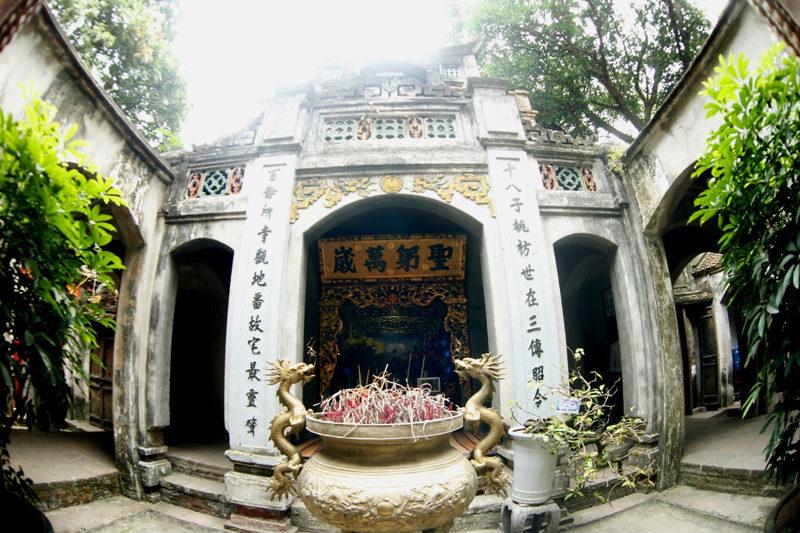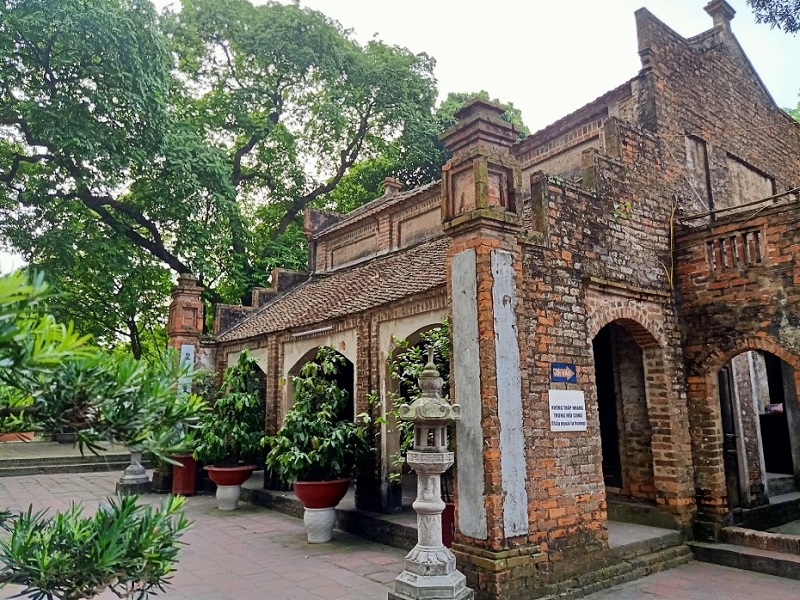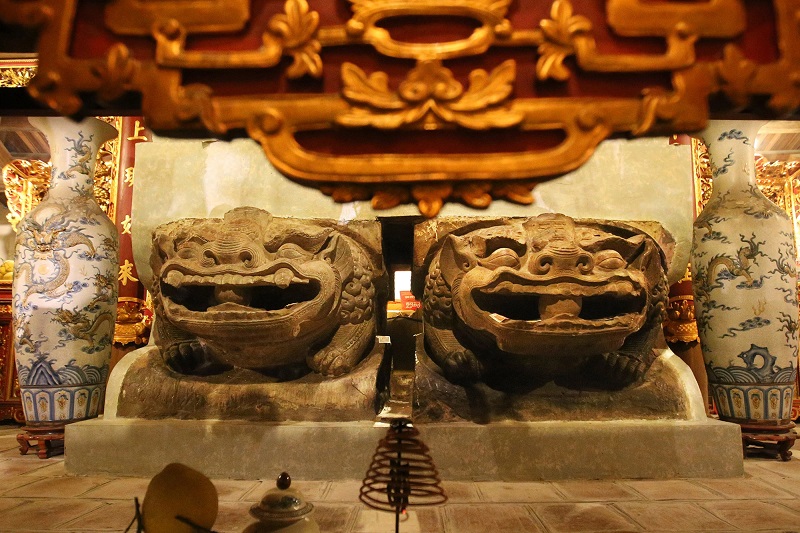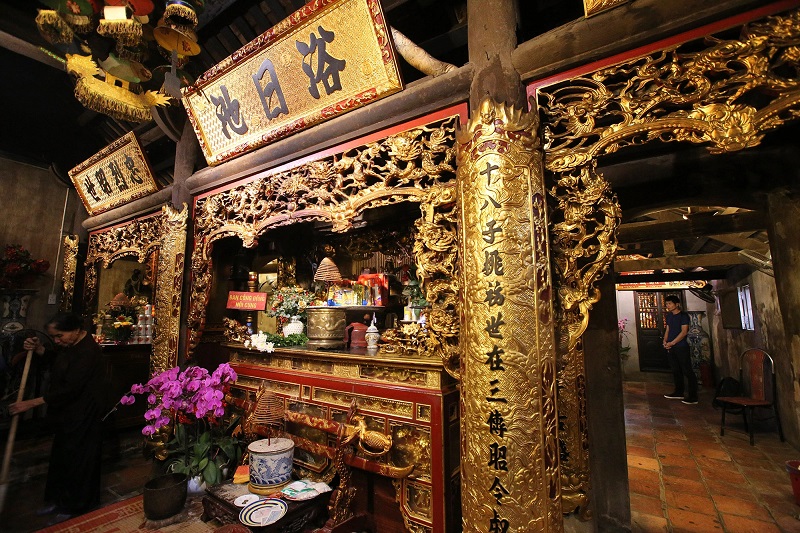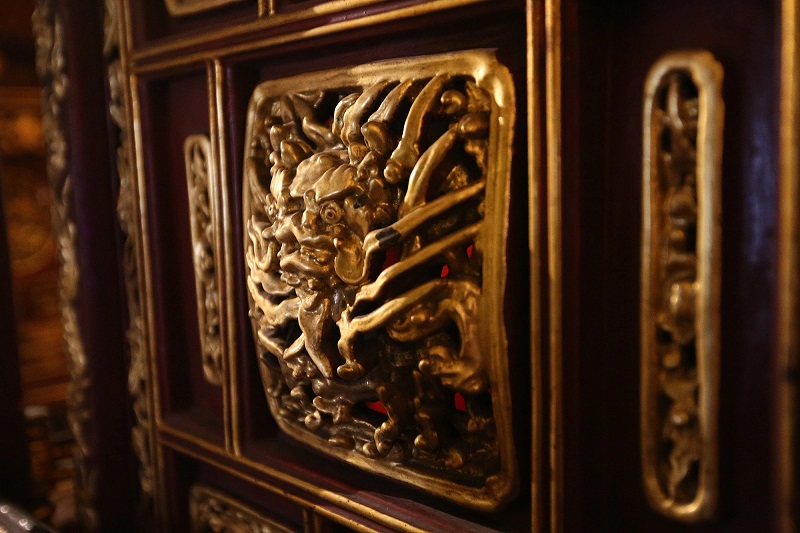Hanoi to launch tour to introduce ancient architecture of Ly Dynasty
The ancient temple and pagoda dedicated to the Empress-regent in Duong Xa Commune, Gia Lam District, are expected to become a new heritage tourism destination, aiming to diversify the capital’s tourism products.
Hanoi will soon launch a tour about cultural values and relics related to Empress-regent Y Lan and some neighboring destinations, such as Bat Trang Pottery Village and Phu Dong Temple in the coming time.
An ancient pagoda with two national treasures
| Ba Tam Pagoda in Duong Xa Commune of Gia Lam District, Hanoi. Photo: Hong Hanh |
Located about 16 kilometers from the center of Hanoi, Ba Tam Temple relics and Pagoda cluster in Duong Xa Commune, Gia Lam District, was built in 1115 in honor of Empress-regent Y Lan (1044-1117).
The Festival of Ba Tam Pagoda and Temple is held yearly to pay tribute to the empress who twice reigned the kingdom in the absence of her spouse and son. This year, the festival coincided with Duong Xa Tourism Week from March 5 to 12.
Legend has it that Y Lan was born in a family who grew mulberry trees, raised silkworms, and weaved silk in today’s Duong Xa Commune. As the wise concubine of King Ly Thanh Tong (1023-1072) and mother of King Ly Nhan Tong (1066-1128), she is said to have made great contributions to the governance of the country which helped the Ly dynasty flourish.
Built by Empress-regent Y Lan, the Ba Tam Pagoda is considered one of the oldest pagodas in Vietnam. Located on the outskirts of Hanoi, the 1,000-year-old structure is home to two of the 27 artifacts recognized in 2019 as “national treasures”.
| Ba Tam Temple in Gia Lam District. Photo: Hong Hanh |
According to domestic scholars, the two artifacts, including the two lion statues (dating back to the 12th century) and a golden gilded wooden altar (dating back to the 16th century), meet three important criteria to be recognized as national treasures, which are: being original and unique artifacts, having a special value in term of culture, history, and art; and being relevant to a famous celebrity of the nation (Empress-regent Y Lan).
The highlight of Ba Tam Pagoda is a large Buddha altar with a pedestal of two stone lions that are 1.2 meters high and 1.36 meters wide. The two lion statues are completely hand carved from monolithic blue stone in a kneeling position.
On the forehead of these lions, the word “king” is written in Chinese characters, dedicating the King’s absolute submission to Buddhism. Meanwhile, the lion’s mane, ears, and mouth are carved with symbols simulating lightning, aura, showing the teaching power of Buddha.
The carved lines are soft, showing the majesty of the mascot while still keeping the affable and gentle features, worthy to be masterpieces of Vietnamese sculpture art in the 12th century.
As for the gilded wooden altar, viewers can’t help but marvel at the talent of Vietnamese artisans living in the 16th century.
The national treasure is elaborately carved with Vietnamese legendary mascots and flowers such as dragon, phoenix, peacock, pheasant, turtle, lotus, and others.
| The two lion statues at Ba Tam Pagoda, Duong Xa Commune, Gia Lam District are among Vietnamese national treasures. Photo: Dan tri |
In addition, Ba Tam Pagoda also owns many other valuable ancient artifacts such as Ly Dynasty stone pillars, ceramics, stone crocodile statues, the ‘jade’ well, and so on.
In particular, the four ancient steles dating from the post-Le era, including the 6th-year Duc Long stele (1635) and the 18th-year Bao Dai stele (1943) record the restoration dates of the pagoda.
The recent archaeological findings have proven the great cultural and historical value of Ba Tam Pagoda.
Realizing the value of national heritage
According to Tran Trung Hieu, deputy director of the Hanoi Tourism Department, Gia Lam District has great potential for tourism development. The district features three tourist sites that have been recognized as urban attractions, including the Duong Xa Relic site, Bat Trang Pottery Village, and Phu Dong Temple.
“It is necessary for Gia Lam District to promote the architectural beauty and cultural value of Ba Tam and Pagoda Relics Cluster as well as other interesting tourist destinations to attract more and more tourists to the locality,” he said at the conference on promoting Duong Xa commune as a tourist destination, which was recently held by Gia Lam District in coordination with the Hanoi Department of Tourism.
| The sophisticated golden gilded wooden altar is recognized as a national treasure. Photo: Dan tri |
Le Hong Thai, HanoiTourist Co.Ltd director, said that Gia Lam District still lacks adequate investment in tourism. Specifically, it lacks high-end hotels and experiential models for international travelers.
“In the short term, the district needs to capitalize on the strengths of existing heritage, especially the cluster of relics associated with Empress-regent Y Lan,” he said.
“Heritage education tours for youngsters may help enhance the value of local relics while promoting them among people,” he added.
In addition to the cluster of relics of Ba Tam Pagoda and Temple, Duong Xa Commune also has 17 historical and cultural relics, five of which are nationally classified. The commune also boasts the Thuan Quang traditional village for processing agricultural products, 18 OCOP products such as turmeric essential oil, turmeric starch, buffalo sausage, among others.
Visitors to Duong Xa Commune will have the chance to visit a 20-hectare orange farm grown according to smart cultivation.
These are Gia Lam’s strengths in promoting tourism. But in order to attract more tourists, it is necessary to have a stronger and more effective tourism policy, according to the conference participants.
| The image of a dragon head on an engraving at Ba Tam Pagoda. Photo: Dan tri |
“It needs to link three tourist sites of the Duong Xa Relic site, Bat Trang Pottery Village, and Phu Dong Temple,” Hieu said. “This is the basis for travel businesses to develop tours to attract tourists to the locality,” he added.
Sharing the same view, Pham Duy Nghia, director of Vietfoot Travel, said that Gia Lam needs to diversify its tourism services.
“A cycling tour to explore nature combined with a visit to cultural relics; or shopping and dining experience in the urban area of Ocean Park combined with a visit to handicraft villages are examples that the local tourism authority should consider,” he noted.
With the close cooperation between local government and tourism service providers, it is hoped that there will be more interesting tours to Gia Lam District that meet the diverse needs of domestic as well as international tourists.

